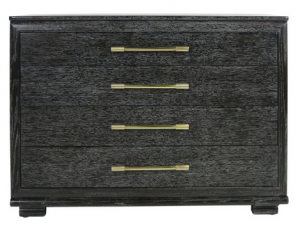Design & Craft Series: The Mengel Furniture Company
By:
Amber Glisson
on 7/24/2015
At VIA Studio, we’re passionate about design. It is the desire to solve problems and the understanding that thoughtful planning can make all the difference that drives us. In our city of Louisville, there have been many talented designers and artisans who’ve accomplished greatness. While they may not be working with the same tools as we do in our daily work, we are inspired by their vision. We see similarities in their principles to our own and are grateful for the lessons we can learn from them. In the coming months we’ll continue to explore Louisville’s design and craft legacy.
From its beginning in 1877 as a lumber manufacturer profiting from the demand for whisky barrels and tobacco boxes in Kentucky, the Mengel Company expanded its reach to become an international producer of lumber products over its 83 years. The company went on to produce wooden car frames and furniture along with other items like toys, windows and doors. Its proximity to hardwood and the strategic railroad network in Louisville facilitated its growth regionally and eventually its ability to include a fleet of ships for exporting overseas. Many designers were involved in the products this company made over its tenure, but there is one that stands out for his design notoriety.
The Industrial Designer: Raymond Loewy
Sometime after World War II Mengel Co. hired a french-american designer by the name of Raymond Loewy to design for a new line of modern furniture called Perminized. Raymond Loewy, who would later be dubbed “the father of industrial design”, has many well-known accomplishments. They include the iconic Shell logo, a Greyhound bus, a S-1 locomotive, the Lucky Strike package, the Coldspot refrigerator and the Studebaker Avanti. From products to corporate identity to public transportation he prided himself on making “the mundane side of the 20th century more beautiful”. While his furniture for Mengel isn’t counted as one of his most notable achievements, its legacy continues as this mid-century modern furniture continues to be collected by aficionados. The items produced possess qualities evident to the philosophies of their maker; concepts he applied to a vast variety of products.

Loewy’s Principles
In his then progressive approach to design, he considered requirements for user friendliness, ease of use, production costs and retail price. His understanding of the economy and production relationship helped him to produce products that competed with other products on price as well as exceeding in design.
While Loewy was an innovator in product design he was also pragmatic. He is known for his concept of “MAYA” (most advanced, yet acceptable). Loewy explains that making an advanced product is a risk for companies in that if the product is too far advanced it will not sell due to the consumers unwillingness to purchase items that are too far removed to what they are accustomed to.

“Between two products equal in price, function, and quality, the better looking will outsell the other.” – Loewy
During the height of his career as a self-described “apostle of simplicity and restraint”, the designer wrote his autobiography, Never leave well enough alone. The book was a best-seller when it was released in 1951 and is still printed and available for purchase. In the book Loewy discusses design dilemmas and strategies that persist in various design disciplines today.

When describing the industrial designer’s theory of aesthetics, he says:
“It would seem that, more than function itself, simplicity is the deciding factor in the aesthetic equation. One might call the process: beauty through function and simplification. Therefore, the test of the designer’s ability lies in his success or failure in establishing simplicity through order. To achieve this, the avenues are clear. First, each component part must be designed efficiently with utmost regard for economy of material. Second, multiplicity being the essence of confusion, the designer will endeavor to eliminate or combine parts, supports, or excrescences whenever possible. This technique I would call ‘reduction to essentials.’ He will then take into consideration colors, textures, and finishes as well as materials themselves and submit them to the same simplification treatment. When every component part has been stripped down to its simplest form, every duplication ruled out, projections and asperities reduced or eliminated, colors and textures simplified, the result is bound to be aesthetically correct.”
A page later he goes on to say, “over simplification also has its dangers” and illustrates the feeling of unbalance it can produce through multiple examples. Throughout a series of stories in the book you learn about he applies this simplification theory holistically to his life and discover the foundations of it. As keen business man and prolific designer his story is a compelling read for any designer.

The Mengel Company undoubtedly hired one the most revered industrial designers of the 20th century for his pragmatic approach to innovation. The remnants of this business relationship are being discussed on forums, sold online and shipped to homes and businesses of people who appreciate his vision and the lovely items it produced. Greater still for some of us that have found a home in Louisville, KY is that we’ve found another example of the rich history of industry and innovation here.
References
http://www.raymondloewy.com/
http://www.raymondloewyfoundation.com/
Related Posts
The best things in life are free… Except for good type.
By: Mitch Wiesen on 5/17/2021
Why you should budget for typefaces in your next creative project.
Read More »How to Make Your New Photos Look Vintage
By: Mitch Wiesen on 9/1/2020
I’ve always been drawn to the warm, friendly way film captures reality. I found my first analog camera, a Canon AE-1, sitting on a blanket at a flea market at age 14, and I was enamored.
Read More »
